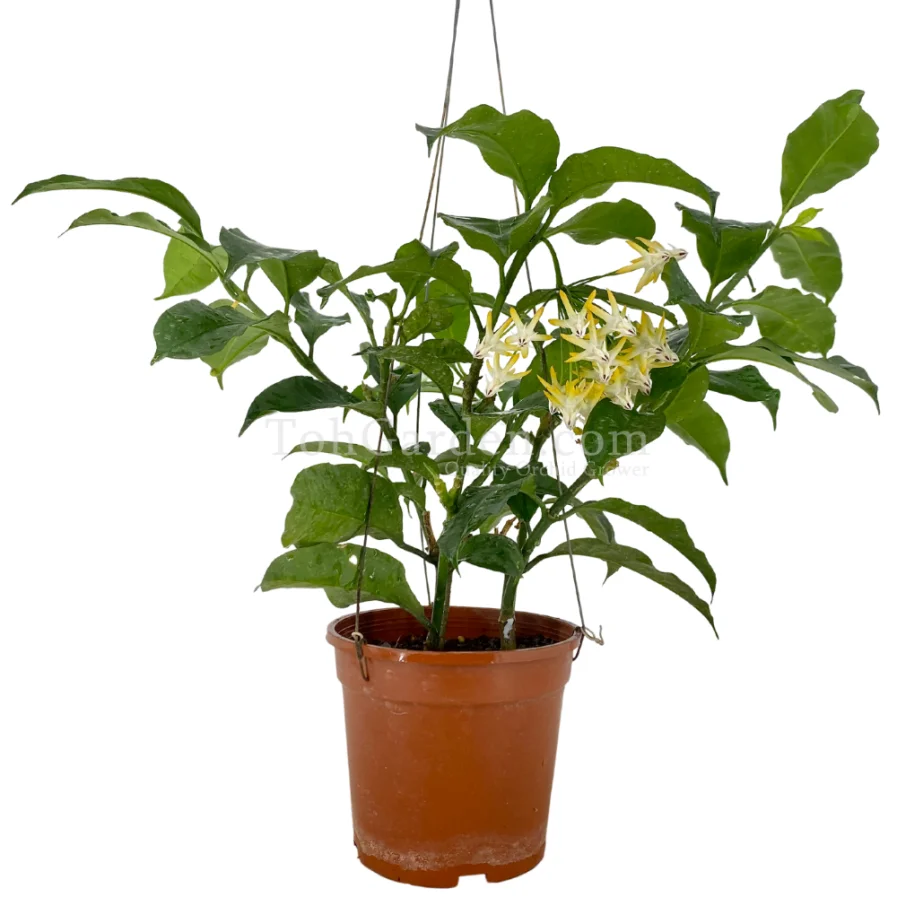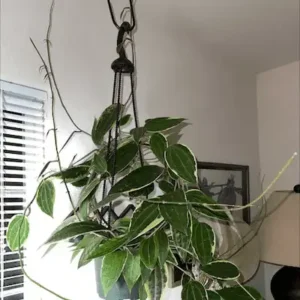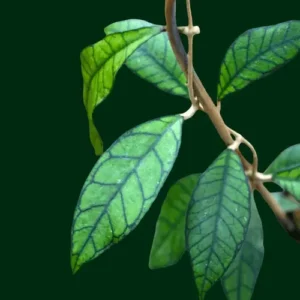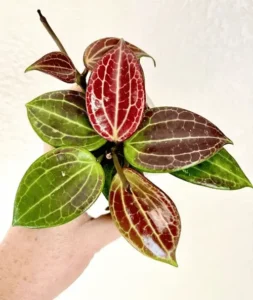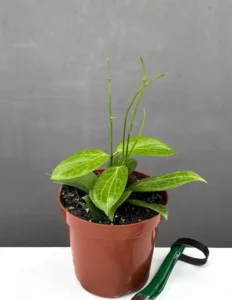Description
The shooting star hoya plant is one of the easiest and most fertile flowers, with glossy dark green leaves. It is a bit bushy with an upright habit and grows 12 to 24 inches high and 8 to 18 inches wide. Additionally, this beautiful wax plant forms large clusters of fragrant white and golden-yellow blooms that look like mini shooting stars.
Facts
Here are some interesting facts about this shooting star hoya plant.
– Choose a suitable pot
For a healthy and happy hoya (plant), mimic its natural warm habitat and choose a suitable pot according to its size. In addition, choose a pot that’s only 1 to 2 inches larger than its root ball for effective growth and has sufficient drain holes.
– Re-pot conditions
In general, hoyas like to be a bit pot-bound. They hate to be disturbed, so don’t disturb it. Only report it under suitable requirements.
– Extra humidity
Shooting Star Hoya loves the extra humidity. So, you can put it in a gallery or a bathroom where a shower is used regularly.
– Shooting star hoya as an outdoor plant
Moreover, when you put this hoya in outdoor places, its mini shooting star flowers attract bees, birds, and butterflies due to its enormous blooms and fragrance.
– Light requirements
For effective growth provide bright, indirect sunlight with stable room temperatures of 60°F and 85°F (16°C – 29°C). Usually, this hoya as an outdoor plant appreciates filtered morning and late evening in the frost tree USDA zone ( a hardiness zone, indicates different average minimum temperatures that plants need to grow).
– Soil requirements
– Soil should be well-drained and well-aerated potting that is gently acidic, as hoya plants don’t like moist soil that leads to root rot which is the most prominent problem among hoyas. Moreover, Root rot may result from the container holding too much water if the plant is not kept root-bound.
watering conditions
– Additionally, overwatering may prevent the plant from blooming and flowering.
However, between watering, allow the soil to dry out. Spring and summer seasons are the most effective seasons for growing the hoya plants. During these seasons, hoya plants require more watering than sleepy wintertime.
– Never cut off the old stems
Never cut off the old stems because new flowers develop on old flower stems. In case, if you cut off them your hoya will not grow.
The main problems with Shooting Star Hoya
The main problems with the shooting star hoya are as follows.
Sap-sucking houseplant pests
It is susceptible to a range of common ‘sap-sucking’ houseplant pests.
Aphids and mealy bugs
These sap-sucking houseplant pests include aphids and mealybugs which are the silent invaders. Moreover, aphids and mealy bugs are the main problems usually associated with this hoya plant.
Solutions to these problems
Solution no 01
-Use neem oil, check plants frequently, keep leaves clean, apply rubbing alcohol, and steer clear of overwatering. In addition, introduces natural predators to ward off aphids, mealybugs, and spider mites.
Solution no 02
-Aphid infestations can be avoided by maintaining target plants that are well-watered, fertilized, and healthy, as well as by eliminating host weeds and neglected stressed plants.
-Aphid infestations originate locally, aphids can be sprayed with organic garlic and chili sprays, squished with fingers and thumb, or eliminated from plants with a water jet.
Other solutions
Use soft insecticides and biological agents
-Most “soft” insecticides and biological agents, which are easily accessible to home gardeners, can be used to control mealybugs.
Leptomastix dactylopii and Anagyrus fusciventris
-Leptomastix dactylopii and Anagyrus fusciventris are parasitic wasps that can be released into an affected area to suppress mealybug populations effectively.
Propagation method
Propagation by stem cuttings from new vines
The shooting star hoya plant is usually propagated by stem cuttings from new vines. Usually, hoya plants are propagated by stem cuttings in water or soil. For better propagation, take a healthy stem and cut below a leaf node. Moreover, for propagating the shooting star hoya, late winter/spring is the best.
Essential and optional aids
-On the other hand, some essential and optional aids can also enhance the propagation success rates. However, use a popsicle-making container (fancy propagation equipment!) for the rooting because it holds the leaves up above the rim.
-Keep water in the container just above the bottom node and when the roots appear. In addition, make sure they’re covered too, and remove all leaves. Also, those at the top of shorter stem cuttings (no more than 1, 2, or 3 nodes) while rooting in a mixture.
FAQs How to propagate Shooting Star Hoya? The shooting star hoya plant is usually propagated by stem cuttings from new vines. Take a healthy stem and cut below a leaf node for better propagation. Moreover, for propagating the shooting star hoya, late winter/spring is the best. How do you take care of a hoya shooting star? Here are some care tips for a healthy and happy hoya. Soil requirements -Soil should be well-drained and well-aerated potting that is gently acidic, as hoya plants don’t like moist soil that leads to root rot which is the most prominent problem among hoyas. watering conditions -Additionally, overwatering may prevent the plant from flowering. In addition, between watering, allow the soil to dry out. Best seasons for watering -Spring and summer are the most effective seasons for growing the hoya plants. During these seasons, hoya plants require more watering than sleepy wintertime. What is the most beautiful Hoya? Here is a list of some of the most beautiful hoya carnosa species. -Hoya carnosa ‘Nova Ghost’ -Hoya ‘Krinkle 8’ -Hoya Carnosa ‘Wilbur Graves’ Can Hoya grow in water? Hoya plants are usually propagated by stem cuttings in water or soil. The most popular hoya species, hoya carnosa is propagated by stem cuttings, seeds, and layering. |
Conclusion
In conclusion, the shooting star hoya is the most effective hoya for indoor and outdoor spaces due to its shooting star-like flowers and enormous blooms. It is well known for its extra humidity requirements for better growth.

